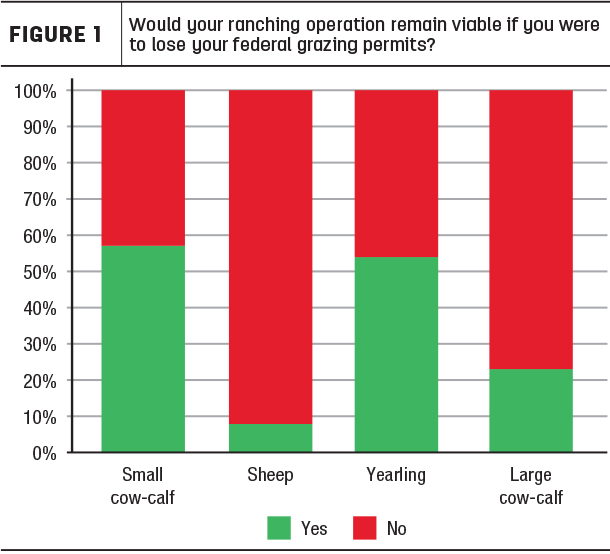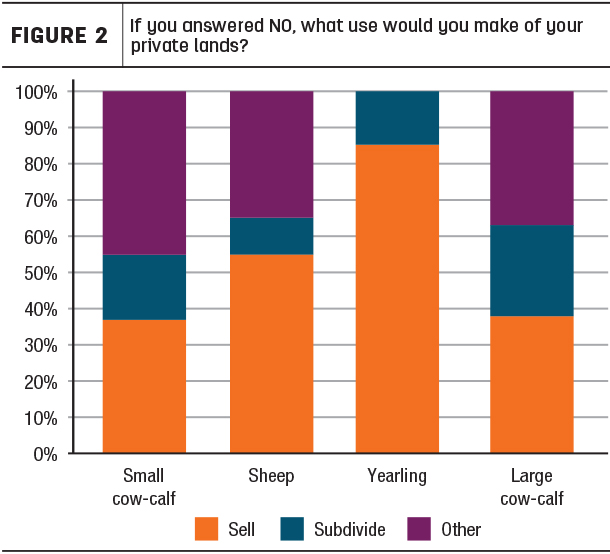A study done in 2015 at the University of Wyoming sought to find out the answer. It tried to answer if there were different types of public land ranchers and if so how these ranchers compare to one another and react to potential changes in policy. The objectives of the study were to obtain statistically valid information at a national scale and on the state level in Wyoming on the social and economic characteristics of public land ranchers, to understand the involvement of ranchers in their local communities and to understand how ranchers would react to certain changes in public land policy.
The study followed a similar study done in the late 1990s that classified public land ranchers. The study design involved surveying a subsample of public land ranchers. The subsample was determined from the public land permittee lists from the BLM and USFS.
A total of approximately 19,735 individual permittees were identified across the U.S. in 2015. From this, a total of 1,911 surveys were sent with 710 completed surveys returned, a 37.2 percent response rate. The questions asked in the survey were developed using three focus groups: the Public Lands Council, several land grant universities and an agency focus group.
In order to determine if there were different types of public land ranchers, a cluster analysis was run that compared the different characteristics of ranchers and grouped similarities. The attributes analyzed were values as to why ranchers kept ranching, their debt-asset ratio, labor, business organization, ranch income, livestock numbers, education level and community membership and leadership.
From this analysis, a total of six distinct rancher types were found. The groups included the hobby rancher, sheep rancher, family cattle rancher, corporate rancher, diversified agriculture rancher and the cattle and sheep rancher.
- The hobby rancher was classified as having 100 head of cattle and income coming from the ranch, as well as off the ranch and retirement income.
- Sheep ranchers were classified as having large numbers of sheep.
- The family cattle rancher was classified by valuing raising a family in the ranching lifestyle as the highest value for continuing ranching and also having large numbers of cattle.
- The corporate rancher had large numbers of cattle and income from the ranch and also had larger numbers of hired labor.
- The diversified agriculture rancher had a more diversified operation by selling ag commodities along with raising cattle.
- The cattle and sheep rancher was classified as having large numbers of both cattle and sheep and all income came from the ranch.
All six rancher groups valued tradition and stewardship as the reasons they continue to ranch every day. All the groups were also very involved in community organizations and were leaders in many of their community organizations.
Once the rancher groups were classified, analyses were run to determine the similarities and differences between the groups. Ranchers were asked to specify what they felt was the largest threat to their operation. Within all groups, ranchers felt that federal regulation and policy was the largest threat. The same was asked for positive impacts to the operation, and across all groups it was found that higher livestock prices were the largest positive impact to the operation.
The most interesting and probably most relatable questions we asked of public land ranchers was to answer what a rancher would have to do in their operation if certain public land policies were changed. These public land policy changes included reductions and additions in animal unit months (AUMs) at the 25 percent, 50 percent and 100 percent level, changes in season of use and changes in the grazing fee. Overall, the responses were diverse, showing how adaptable and out-of-the-box thinking public land ranchers are.
The study also intensified results at the state level in Wyoming. Many of the same questions were asked, but two very unique questions were asked of Wyoming ranchers.
The first asked ranchers to describe ways that they felt their ranch contributes toward the Western custom and culture lifestyle. It was found that family tradition, open space, livestock and the Western way of life were ways in which Wyoming ranchers felt they contributed.

Ranchers were also asked to describe ways that their ranch contributes toward the economic vitality of their local community and state of Wyoming. Responses included community, buying local, taxes and employment.
Lastly, Wyoming ranchers were asked if their ranching operation would remain viable if they were to lose their federal grazing permits and if the ranch could not remain viable, what they would do with their private lands. The majority of ranchers answered that they could not remain viable without their federal grazing lands and they would have to sell or subdivide their private lands.

Overall, this study showed the diversity of public land ranchers and that a one-size-fits-all approach is not the best solution. The information for this study will hopefully help the agencies in their social and economic sections of policy documents and will help them better understand the diversity they are faced with when it comes to public land ranchers. ![]()
Bree Lind is a range scientist with Y2 Consultants in Jackson, Wyoming. Email Bree Lind.
PHOTO: Today's public land rancher continues to express the need for stewardship and care for the land. Photo by Paul Marchant.







